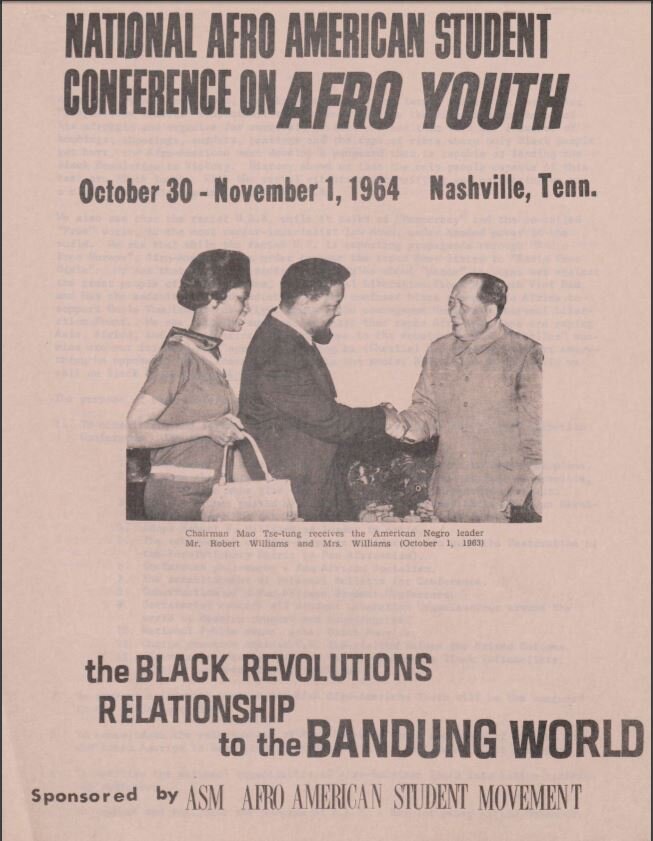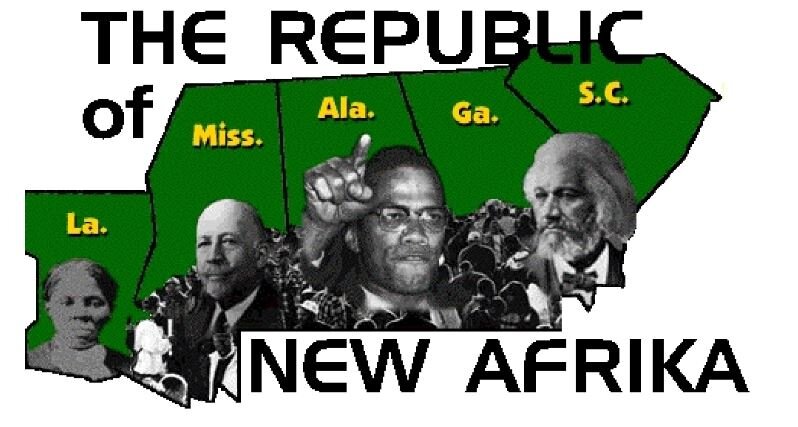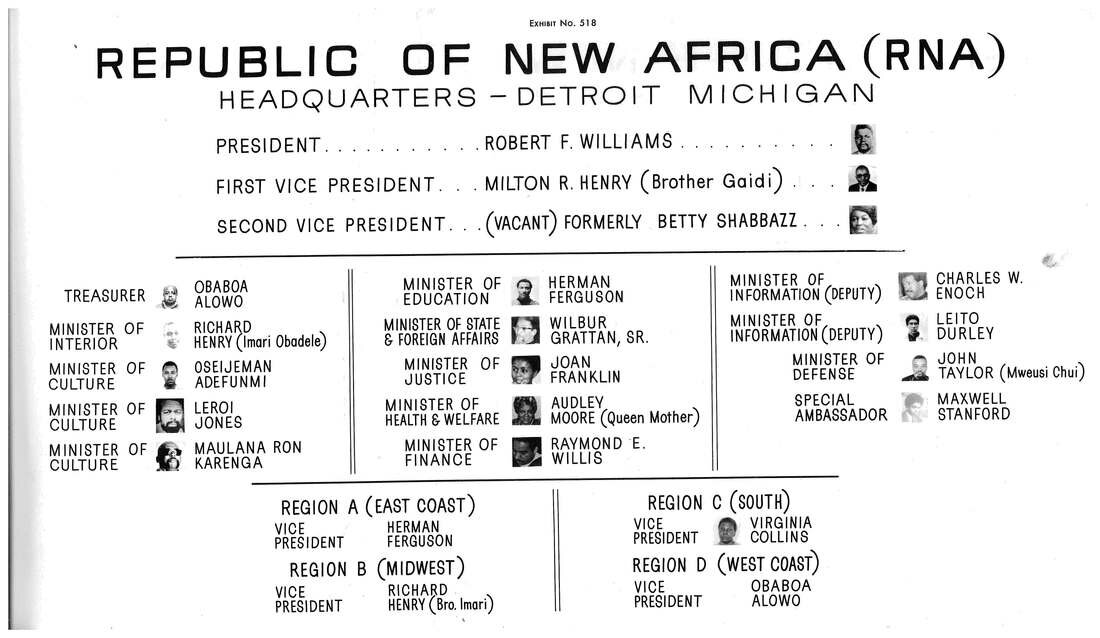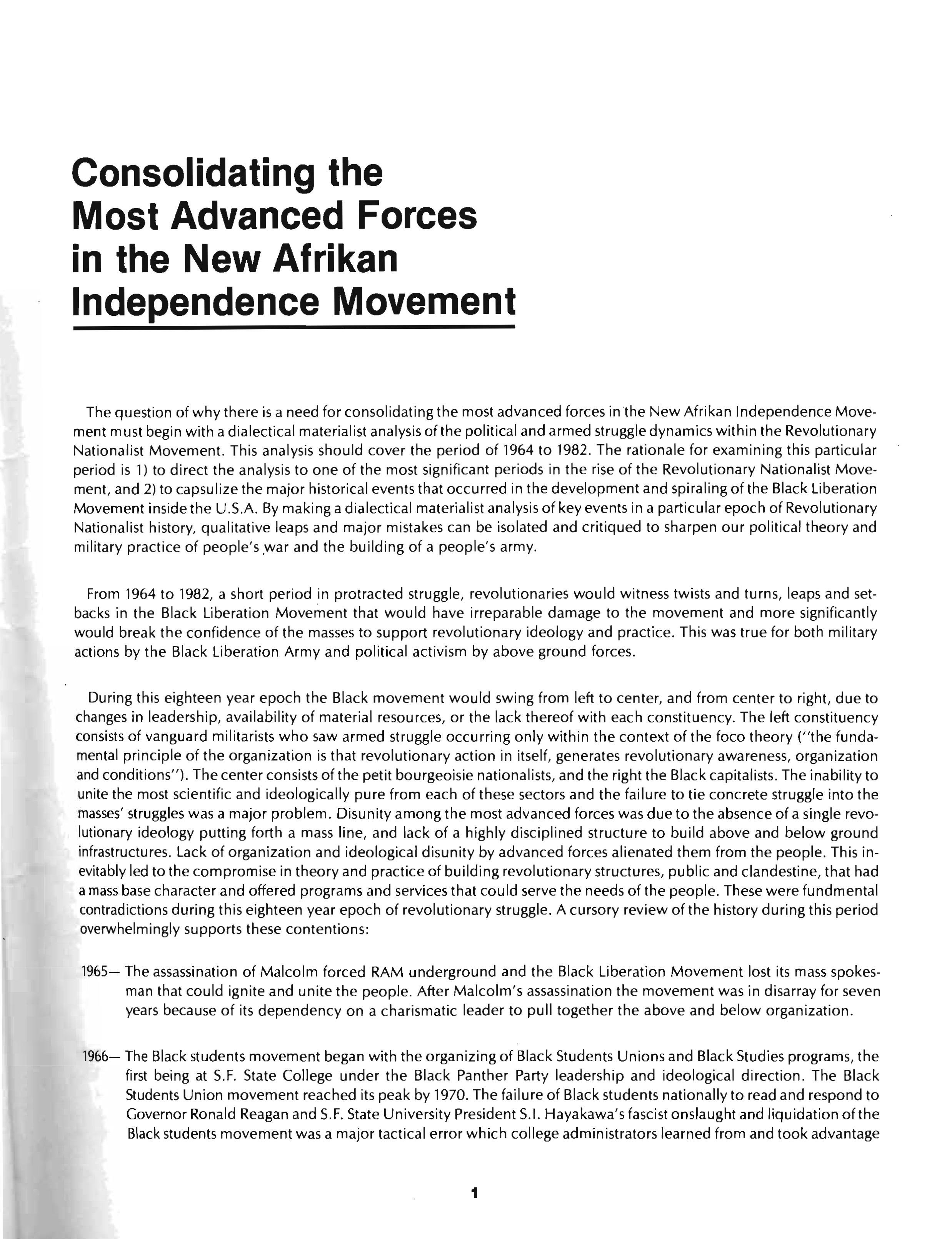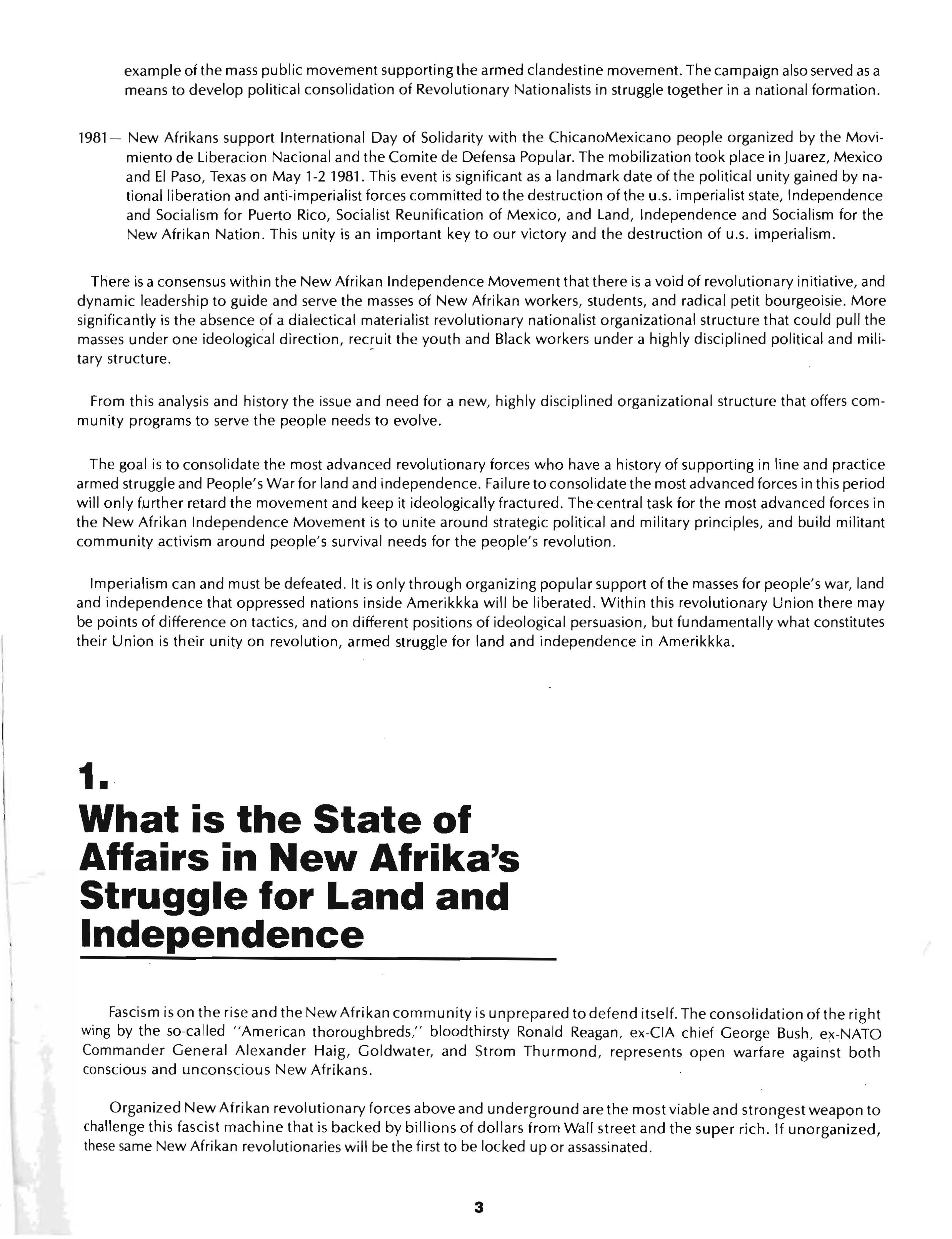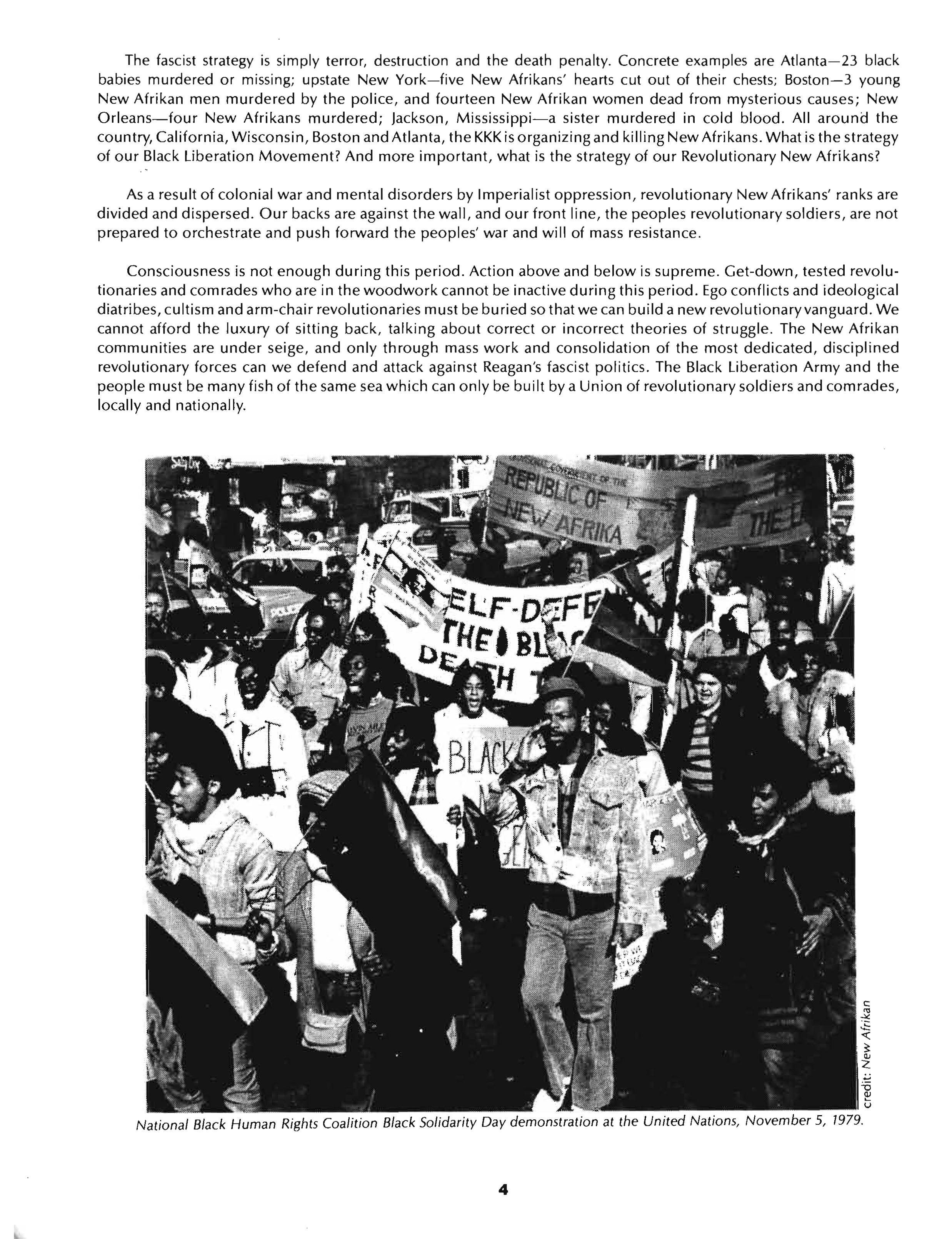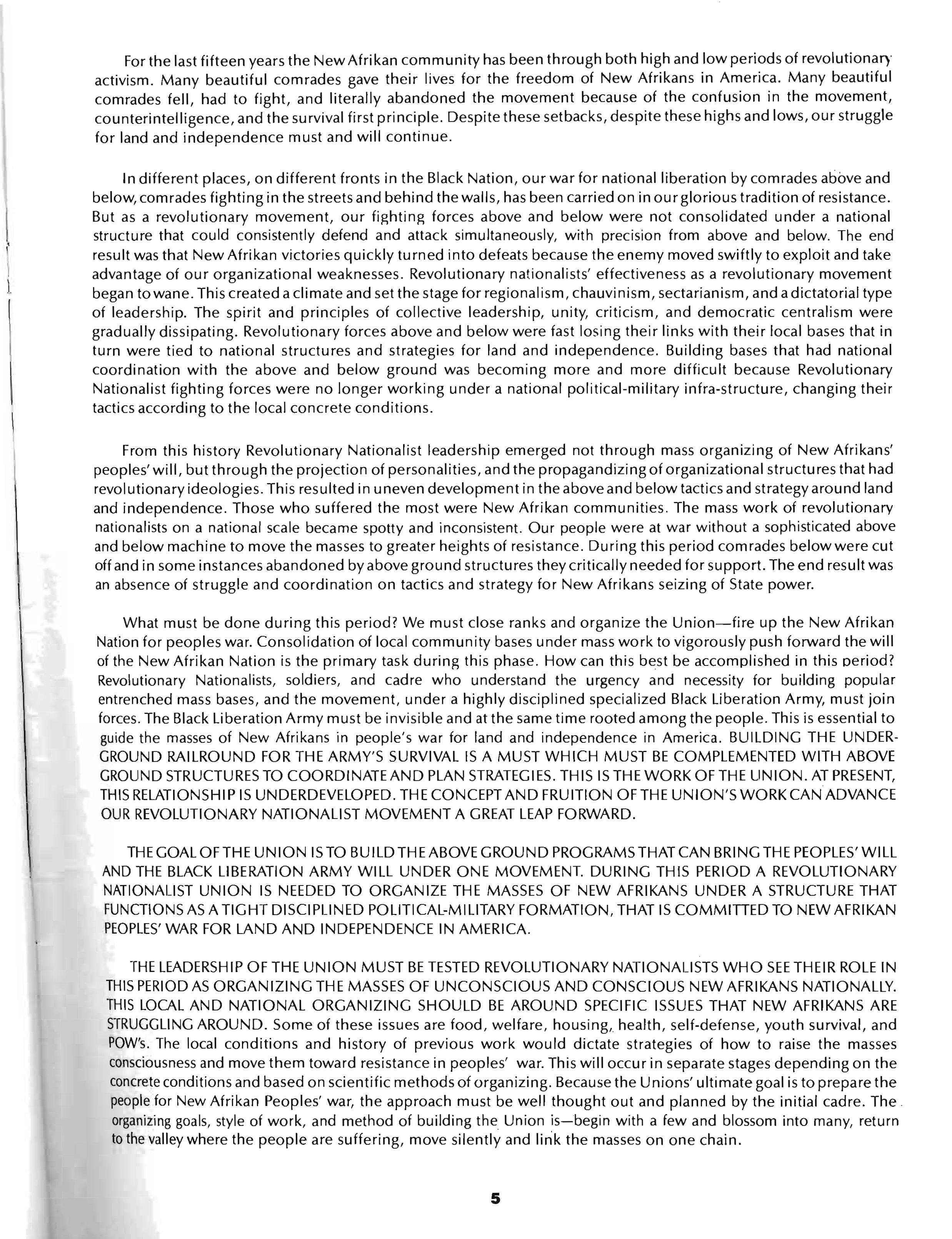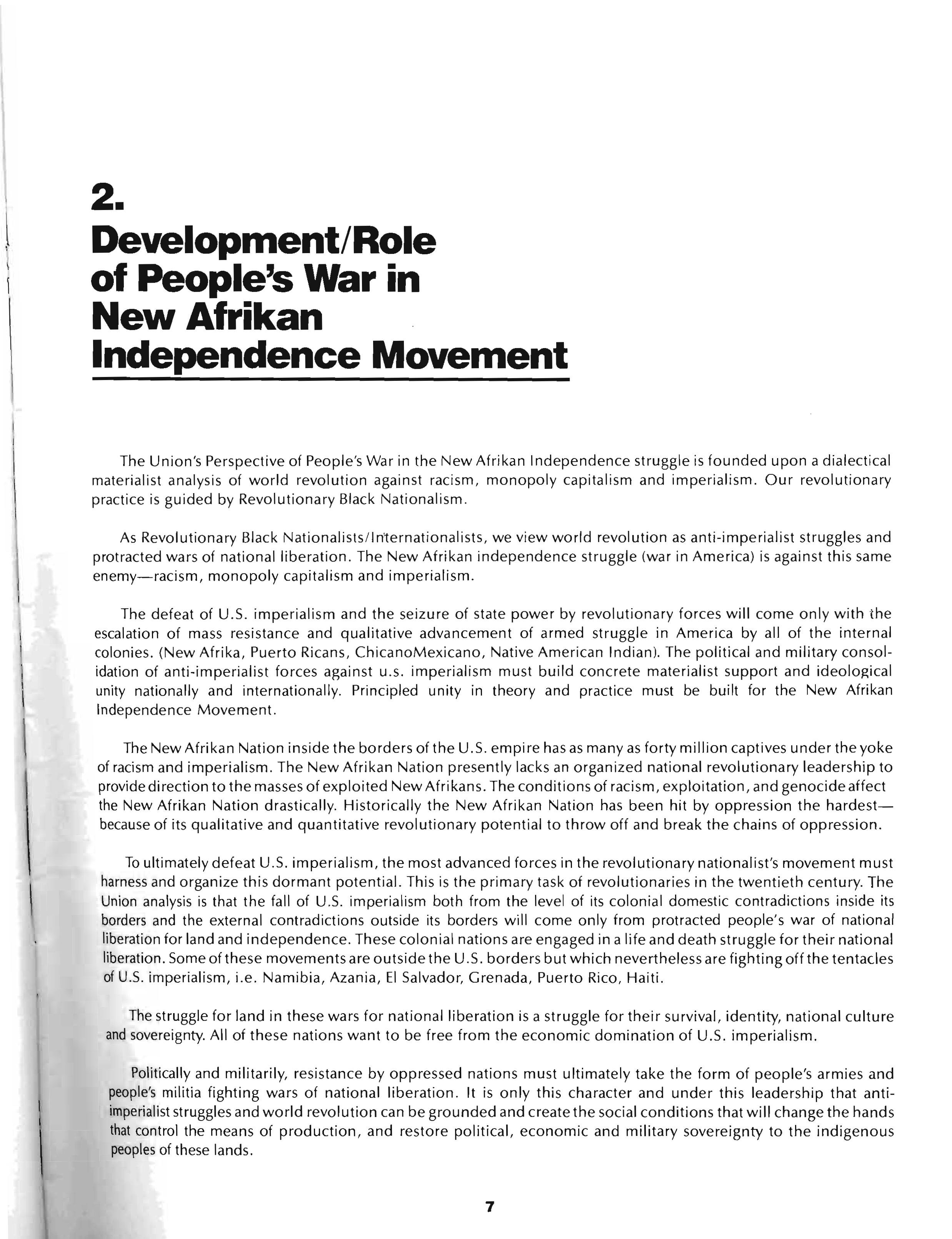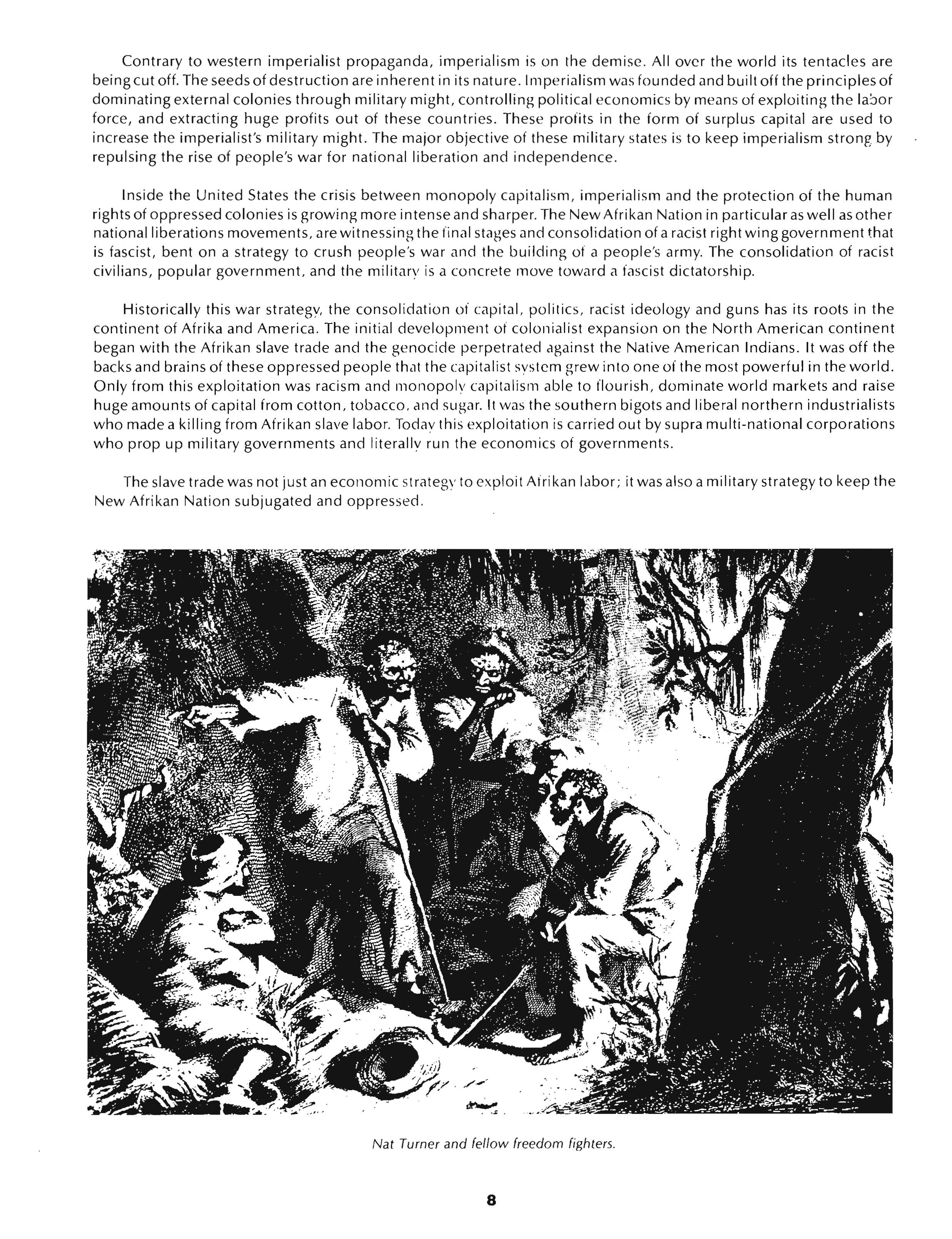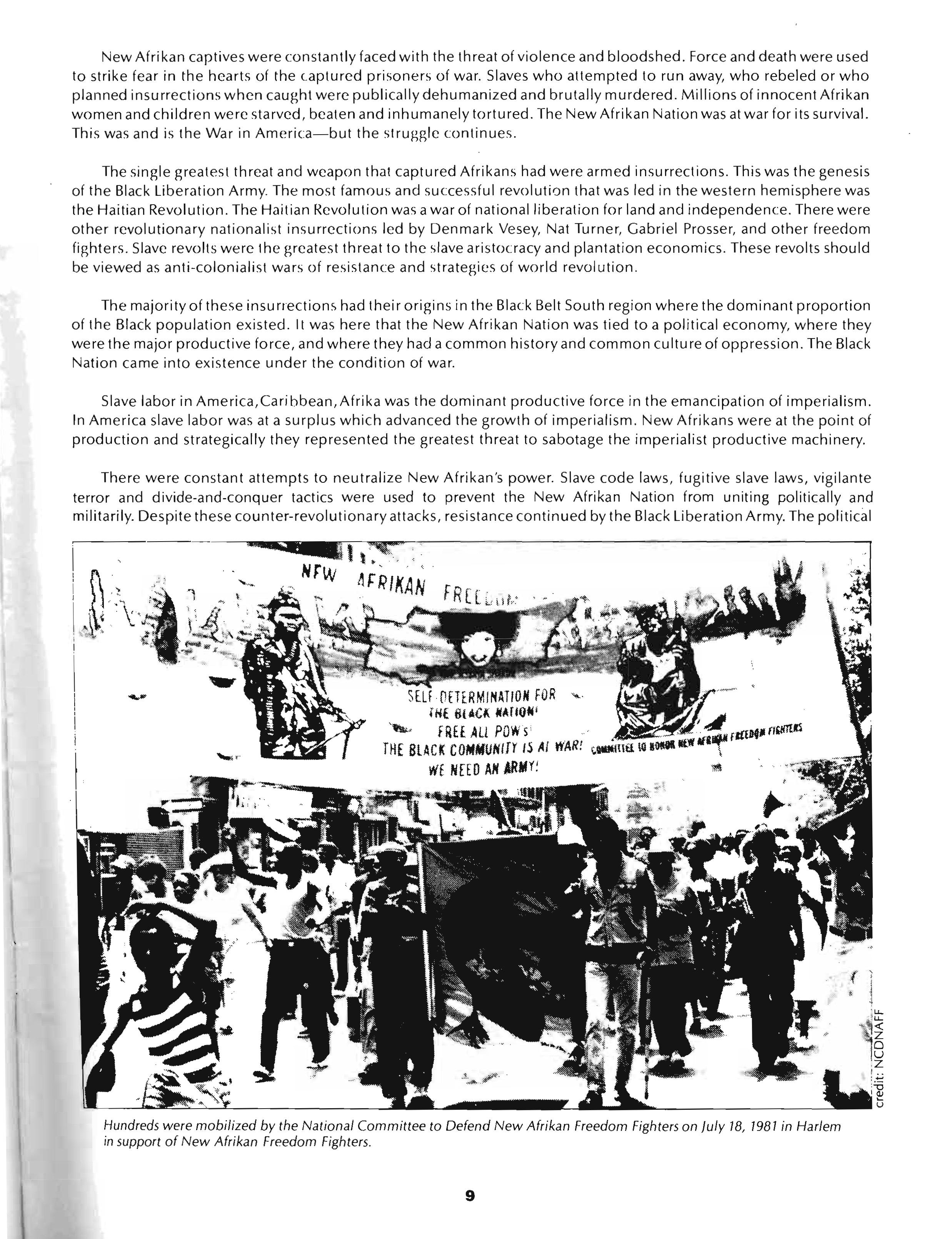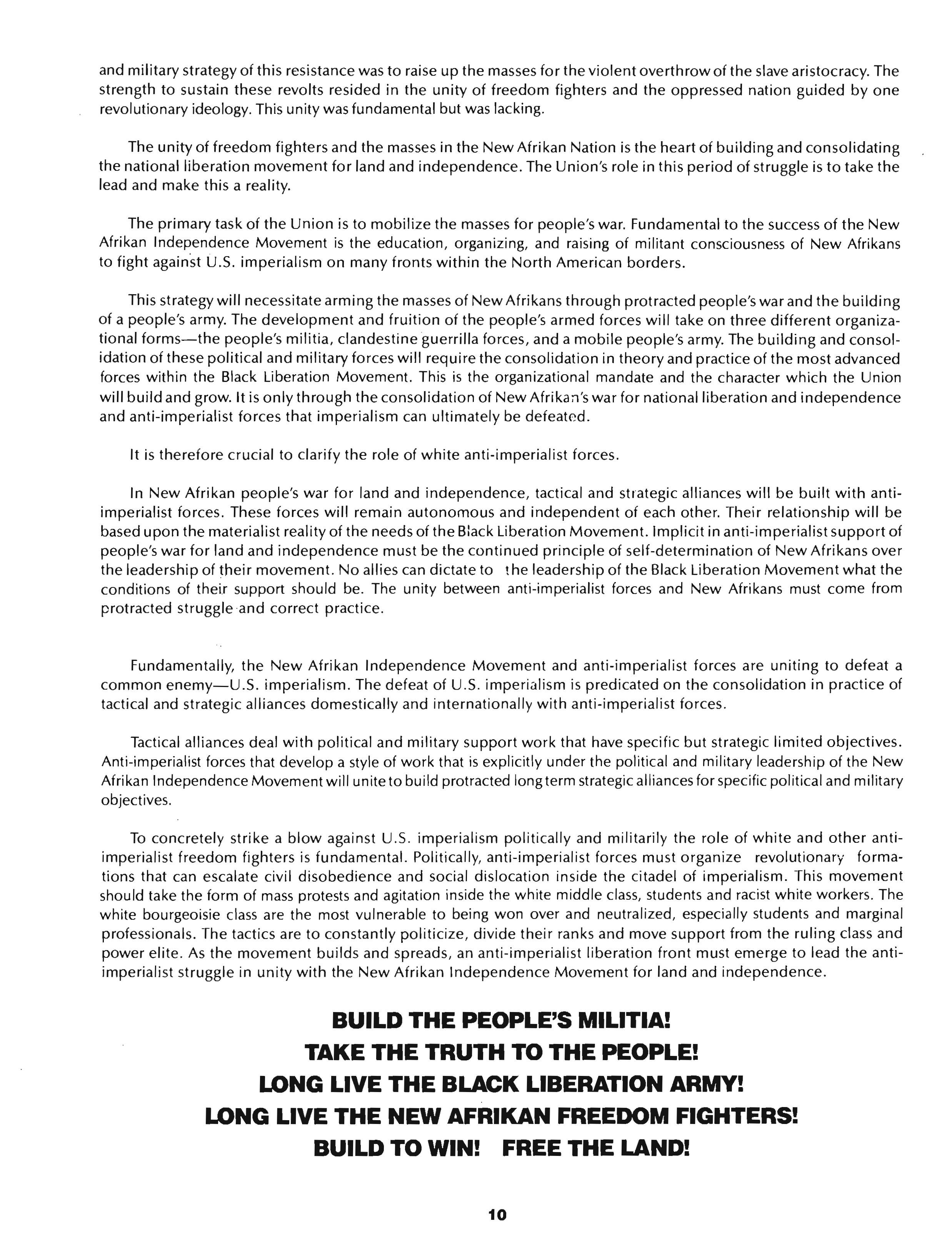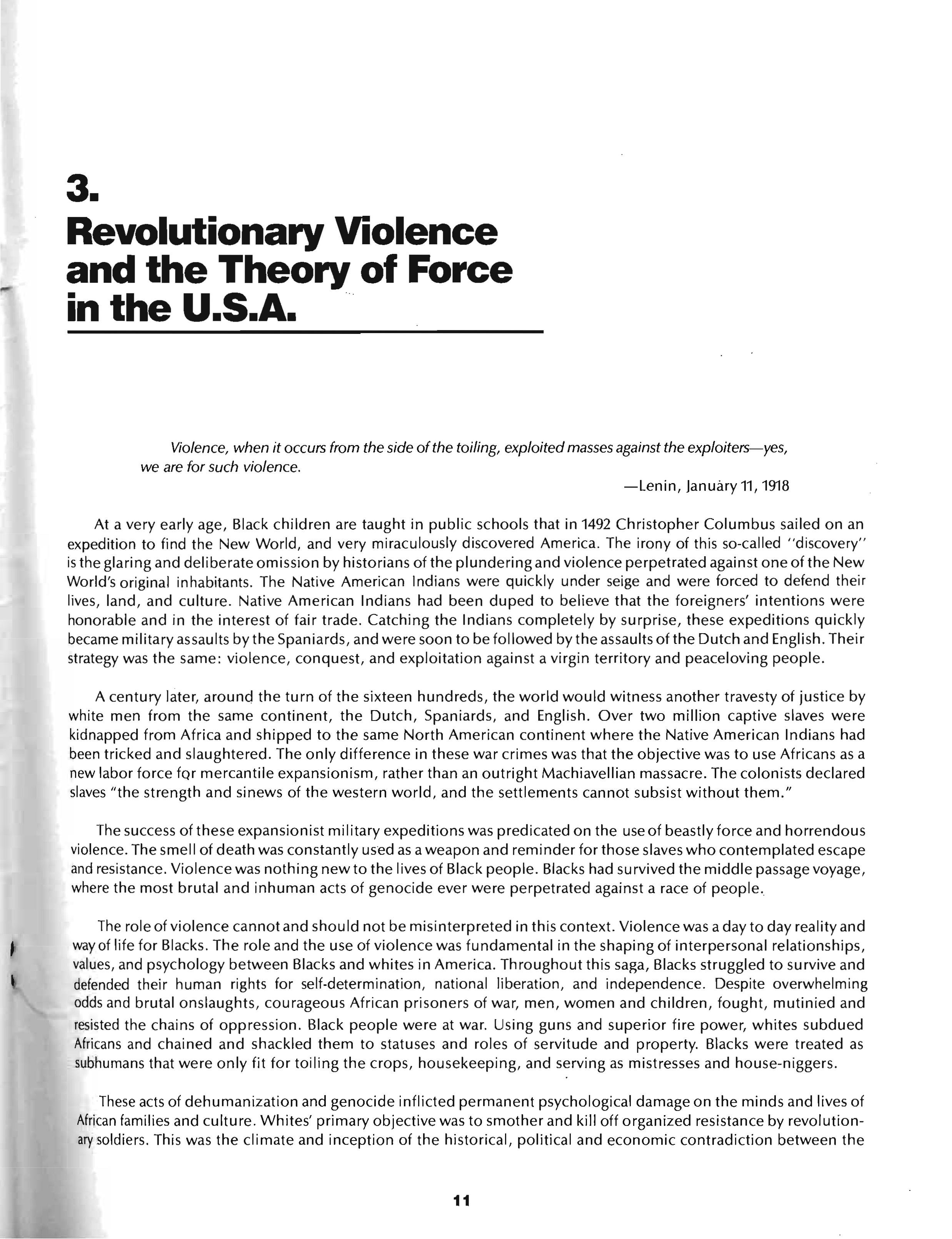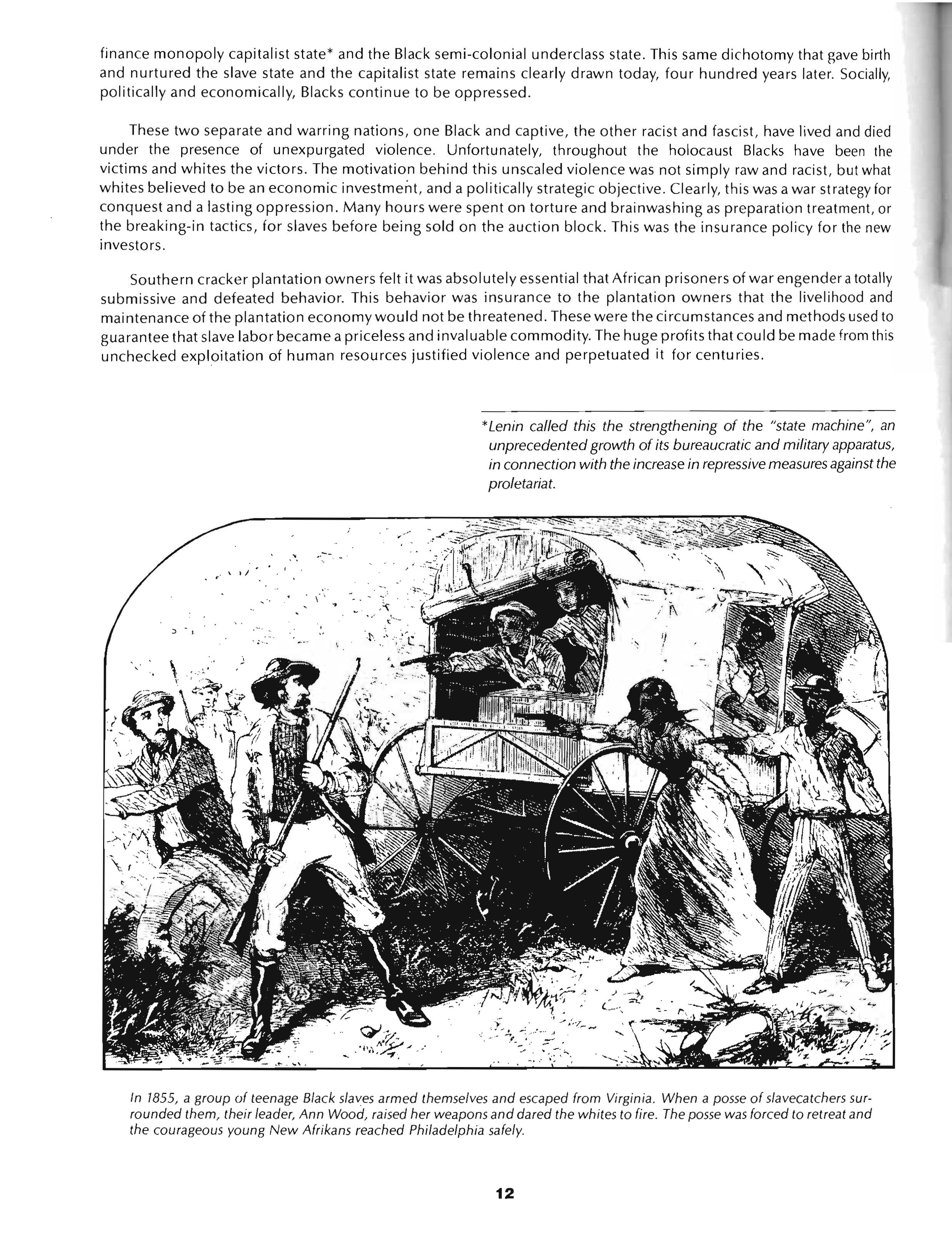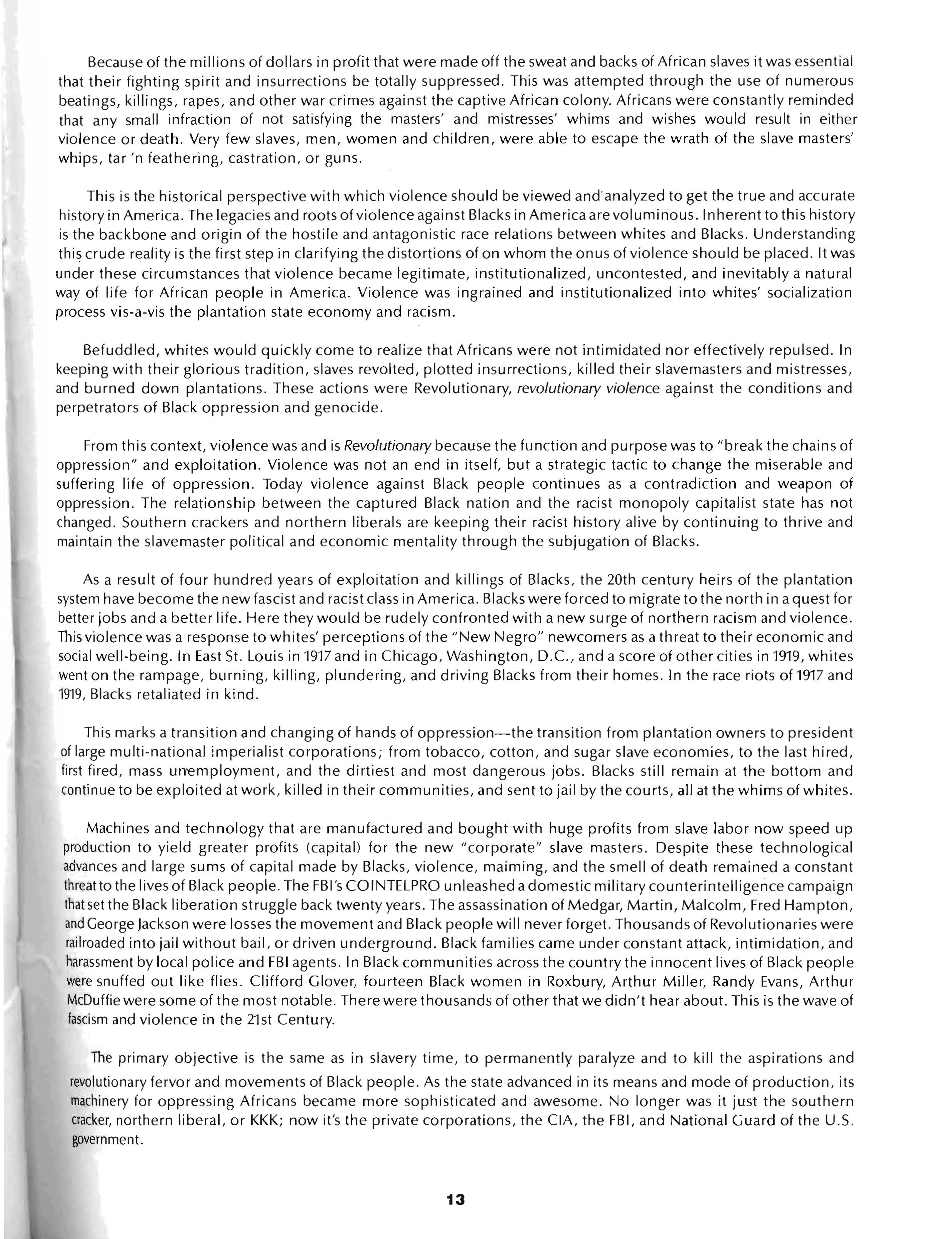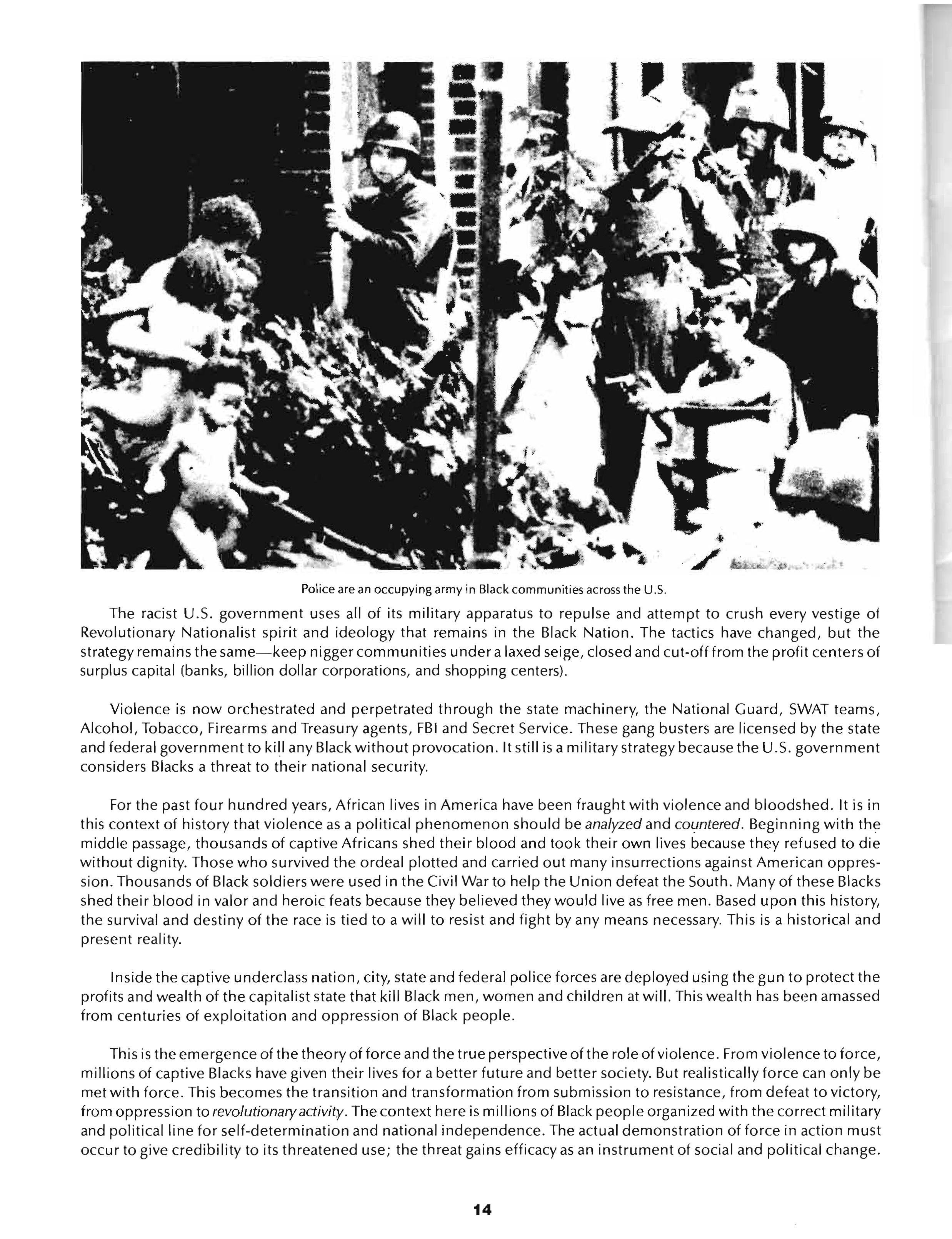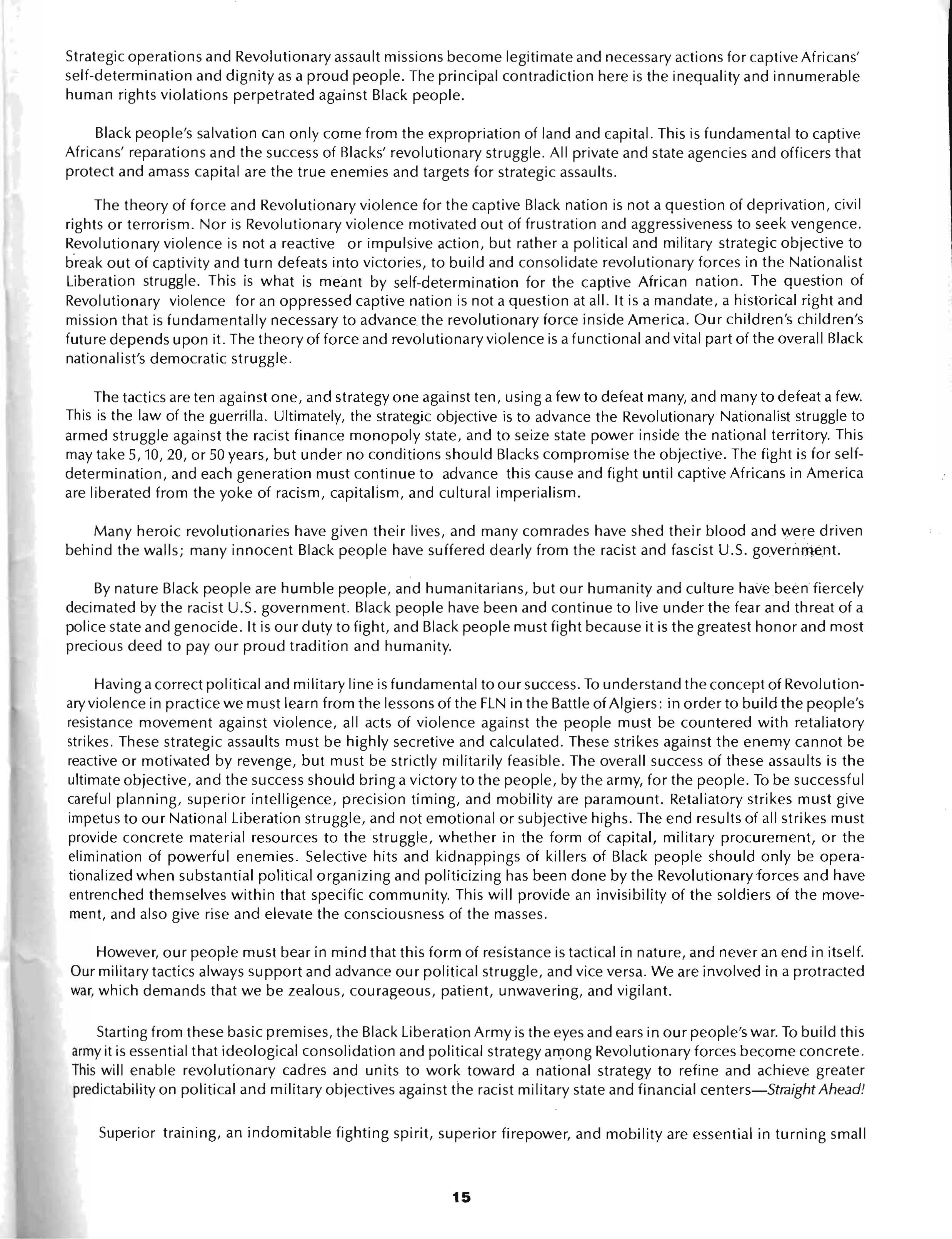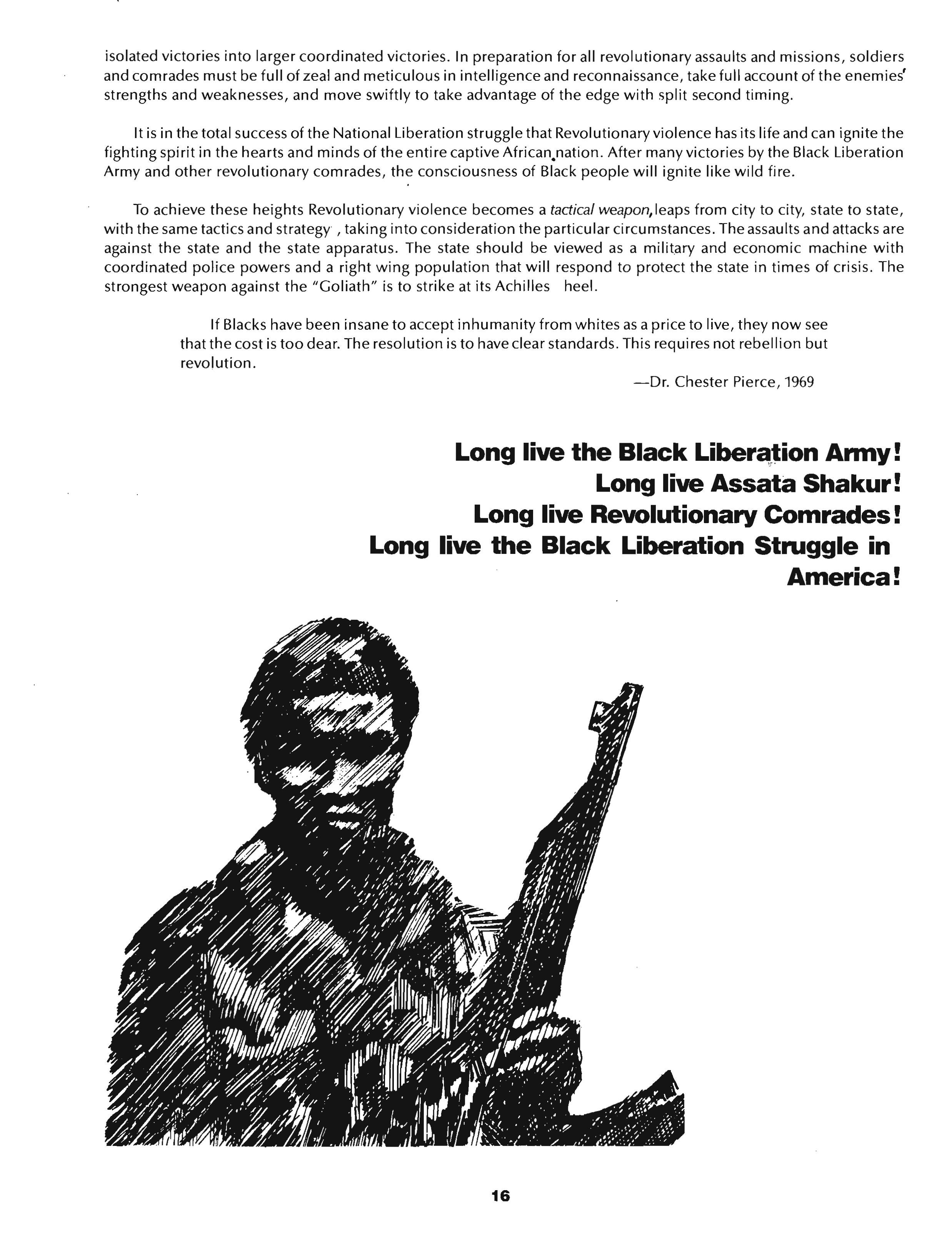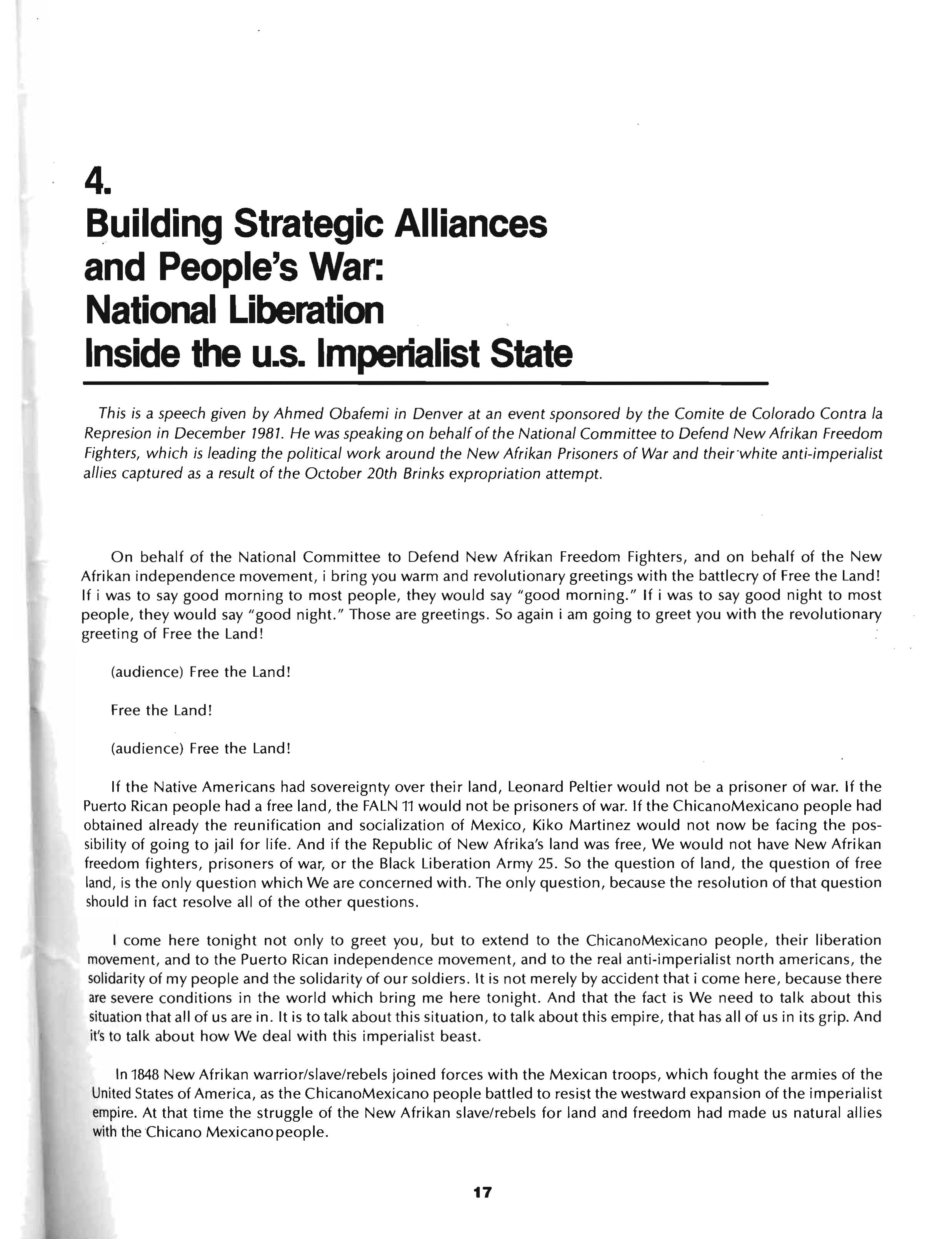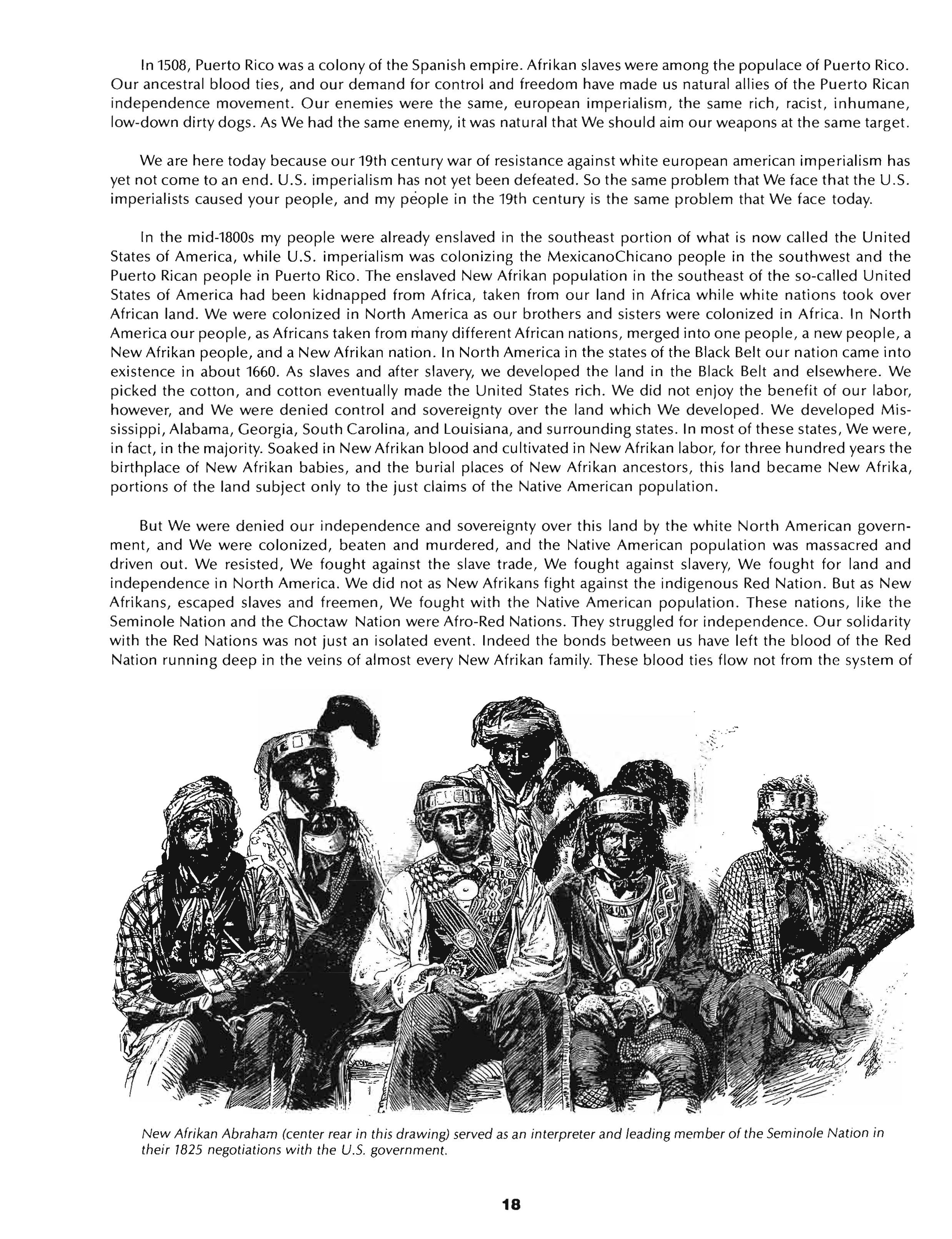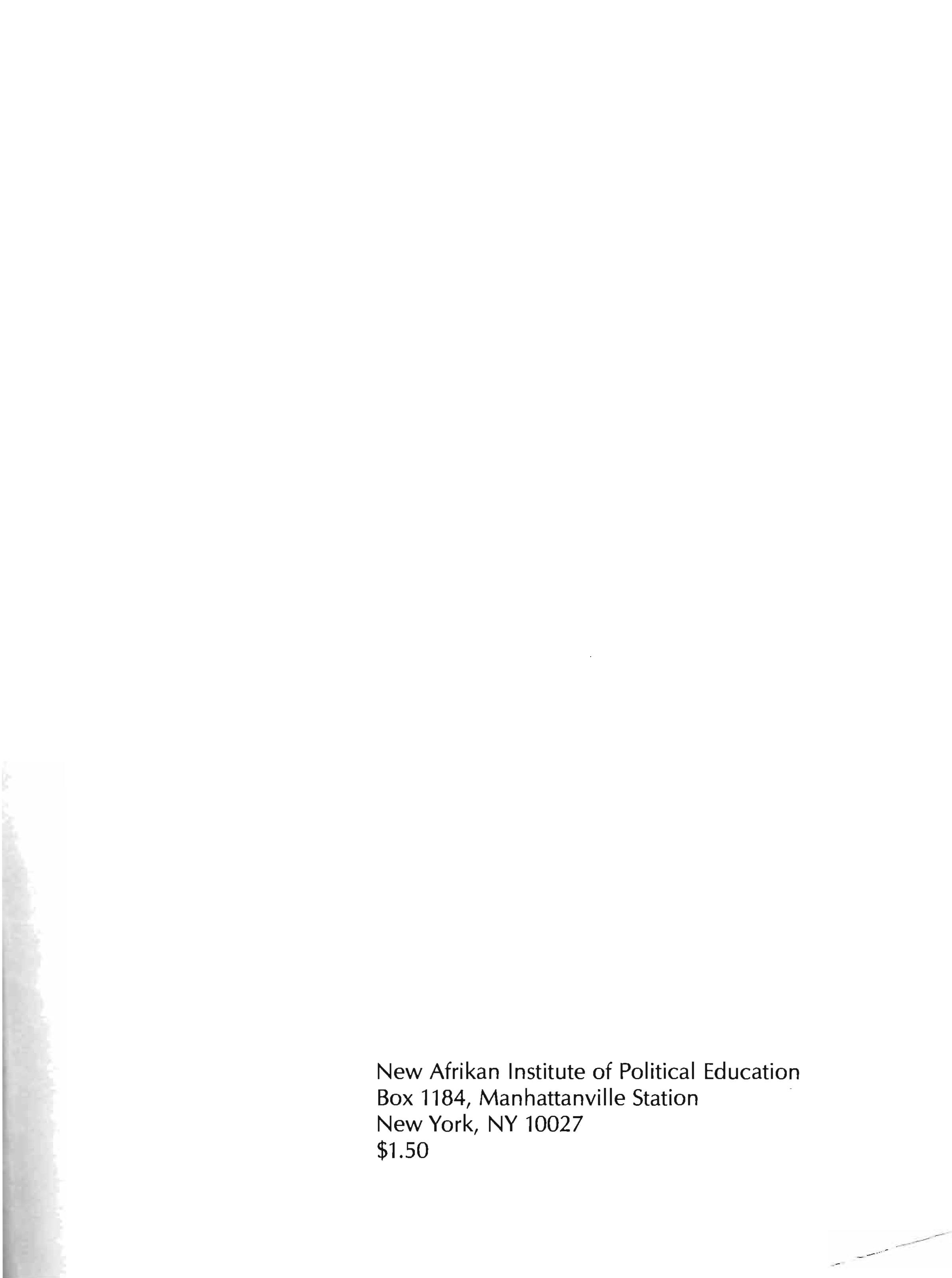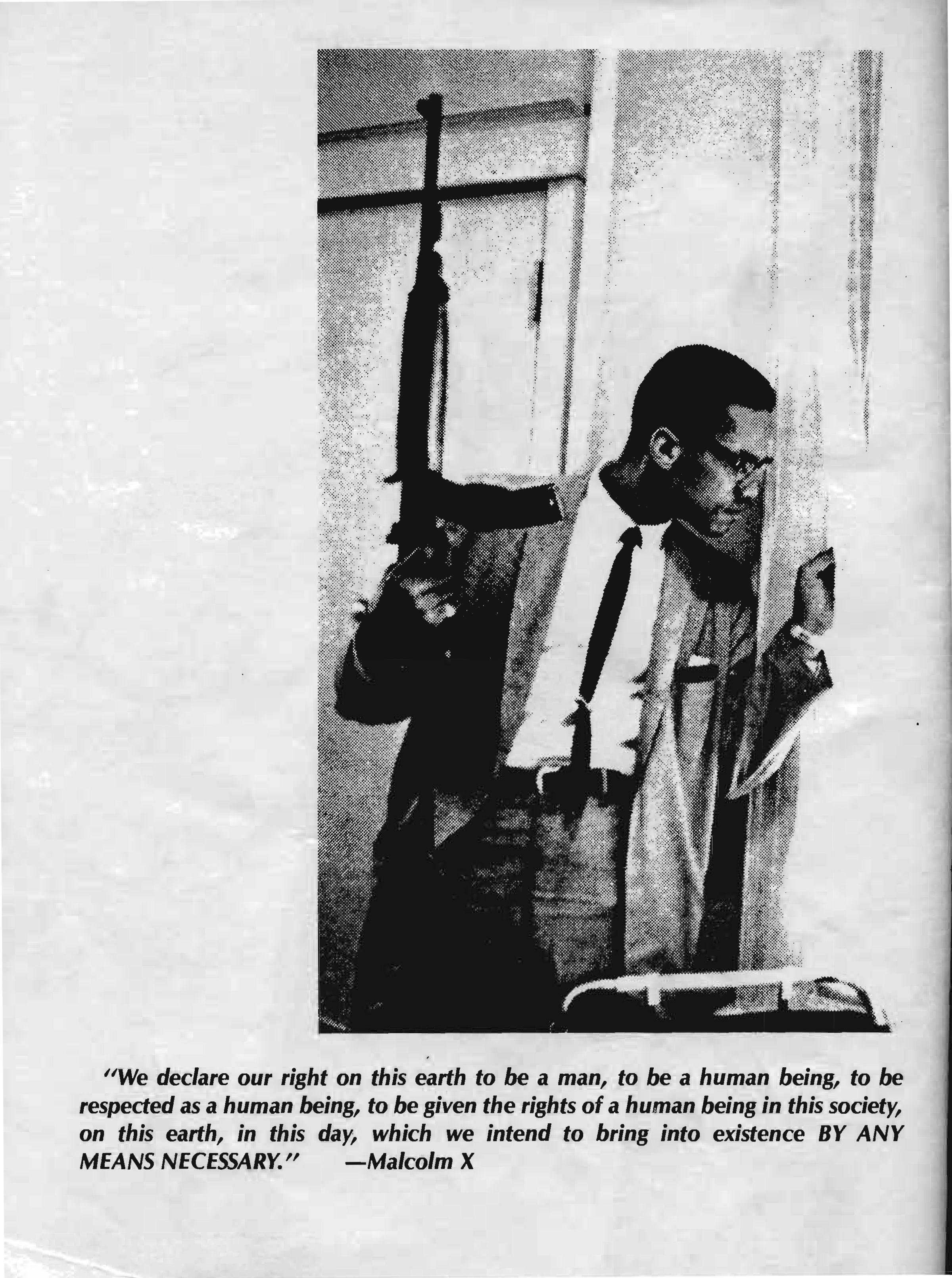AN OVERVIEW
We will start with the basic fact that Capitalism and Imperialism as an economical system is in a deep crisis at home and abroad. The basis of this crisis is, of course, the exploitive relationships that capital must maintain in order to function. It is these economic, social and political relationships that signal the eventual doom of our oppressors and this system of oppression under which we all live.
This crisis of Capitalism is of a protracted nature, by this we mean it is a long process of deterioration that is spread over a considerable length of time. The seeming material wealth which we see all around us in no way contradict this fac:t of decay, deterioration or the fact of crisis. In fact, overproduction and uneven distribution have led time and time again to a bloated market, cutbacks in employment, and all the attendant ills of an economy based on private ownership of socially produced commodities. Inflation, soaring prices, and inadequate wages are all symptoms of an economy that is based primarily on class exploitation at home and national domination of the Third World's resources abroad.
The heightening of oppressed peoples struggles abroad have added to the crisis of the entire western world, and threaten to cut drastically its essential resources. We realize that the chief economical and military power in the western world and its ruling class, namely the United States of North America and its corporate-financial ruling circles, will never allow the demise of its empire without a desperate fight. We, as blacks in North America must realize, that to seek inclusion into the prevailing socio-economic system is suicide in the long run, for the prevailing system cannot withstand the irresistible world trend of history which is opposed to continued U.S. exploitation, racist domination and subjugation. To fool ourselves into believing that "equal opportunity", "justice", and social equality is the same as the capitalist system is a grave mistake with genocidal implications for every person of color. Our first obligation is to ourselves, this means our first obligation is to secure our total liberation from those forces that maintain our oppressive condition. Related to this self-obligation (not distinct from it) is our obligation to all oppressed peoples throughout the world, for in striving to liberate ourselves we must abolish a system that enslaves others throughout the world. This, in essence, is our historical duty, we can either carry it out or betray it, but we most certainly will be judged accordingly by the world's peoples.
The B.L.A. as a result of realizing the economical nature of the system under which we are forced to live maintains the following principles:
1. That we are anti-capitalist, anti-imperialist, anti-racist and anti-sexist.
2. That we must of necessity strive for the abolishment of these systems and for the institution of Socialistic relationships in which Black people have total and absolute control over their own destiny as a people.
3. That in order to abolish our system of oppression we must utilize the science of class struggle, develop this science as it relates to our unique national condition.
In a society such as exists here today, law is never impartial, never divorced from the economical relationships that brought it about. History clearly shows that in the course of the development of modern western society, the code of law is the code of the dominant and most powerful class, made into laws for everyone. It is implemented by establishing "special" armed organs, that are obliged to enforce the prevailing class laws. In this historical period of human social development such is the objective function of "law".
Under such conditions of the most powerful economic and political classes. But, what about the law in a democracy, especially one that claims that all its citizens can elect their representatives who in turn can create new laws? First of all such a democracy does not exist in North America, bourgeoisie democracy is essentially the dictatorship of what used to be termed the "national bourgeoisie". There are a combination of reasons as to why this form of democracy as such is merely a means of political control that evinces a design to subjugate its people, all of these reasons flow from the necessity to maintain exploitative capitalist relationships. Thus, the influence of corporate wealth on the politics of bourgeois democracy is merely an extension of private property's traditional influence and control of the so-called democratic process. The Constant co-optation by ruling classes of the masses of working peoples, coupled with their complete control of technology _and information, renders the so-called democratic process null and void. To a greater degree all social and political institutions in a class society are reflections of the class organization of that society of the reflection of a given technological-economical arrangement and its supporting value system. The political organization of the most powerful classes or economic groups in a class society has to be, and is, the control by these classes over the entire society and its political system. We have found the democratic process under capitalism to be merely a means by which capital controls the masses. It is a means of mass diversion, designed to keep the powerless classes politically impotent while at the same time fostering the illusion that real power can be gained through the electoral process. Black People should know better. In a nation based on the false principle of majority rule we are a marginal minority and therefore our right to self-determination cannot be won in the arena of our oppressor.
The rejection of reformism however, is much deeper than the above reasons. For if reformism is a rejection of any meaningful change, it is also a rejection of revolutionary violence, and therefore reformism is a functional ignorance of the dynamics of Black liberation. This is because the character of reformism is based on unprincipled class collaboration with our enemy. The ideals of class collaboration do not stand in opposition to our peoples oppression, but instead consistently seeks to reform the oppressive system. Reform of the oppressive system can never benefit its victims, in the final analysis the system of oppression was created to insure the rule of particular racist classes and sanctify their capital. To seek reform therefore inevitably leads to, or begins with, the recognition of the laws of our oppressor as being valid.
Those within the movement who condemn the revolutionary violence of anti-capitalist, anti-imperialist, and revolutionary Black nationalist groups are in essence weakening themselves. These fools do not under stand the inter-active need for revolutionary violence with other forms of struggle, and because they do not understand the real dynamics involved they seriously inhibit the development of the liberation movement as a whole... These reformists in liberationist garb should understand that unless the movement cultivates its capacity to fight the enemy on all fronts, no front will secure any real victories. It is abysmal ignorance that imagines our oppression in any other terms than undeclared war.
How will the movement as a whole be able to fight the oppressor in the future when all other "legal" methods are completely exhausted? How will we implement political struggle without the machinery and capacity for revolutionary violence-when it is abundantly clear that our oppressor maintains armed organs of violence for the enforcement of his rule? We as a movement will be unable to fight in the future if we do not develop the capacity for revolutionary violence in the present. But revolutionary violence is not an alternative to mass movement and organization, it is complementary to mass struggle, it is another front in the total liberation process. Those who put the question of revolutionary violence in "alternative" terms are guilty of crippled politics at best or reactionary politics at worst. Those involved in the total revolutionary' process, yet claim not to "endorse" revolutionary violence when it occurs, are attempting to "legitimize" their existence at the expense of the entire struggle. The only "legitimacy" these people can possibly be seeking in such cases is bourgeoisie legitimacy. These type people further confuse the masses, for revolutionary violence is not clarified and extended in order to undermine the psychological dependence black people still have on racist reactionary "legality". This is the vilest of sins, one for which everyone will pay during heightened repression.
We therefore do not view the "law" of our class enemies as valid, nor do we feel restricted in struggle to his laws. On the other hand, we understand the "tactical" value of using the law and consequently we understand the tactical value of reform in the liberation process. For example, school takeovers by community parents, rent strikes by tenants, labor union takeovers by dissident members, etc.; utilizing their systems and built-in safeguards to obtain certain goals that place the enemy at a temporary disadvantage. But we maintain· there is only tactical value to reform when there exists other forms of revolutionary struggle against the whole of the capitalist structure. Reform as such is inherently reactionary and perpetuates psychological dependence on the enemy, while confusing the true class contradictions between ourselves and the enemy. Considering these factors, we maintain that reform can never be anything more than a tactic, never a complete strategy, never offering in itself any revolutionary change. While it may offer the Black bourgeois rewards, it can never be the road to self-determination for the entire black populace.
We also strongly condemn those who claim to be progressive, yet depreciate revolutionary violence of an oppressed peoples in their struggle for liberation. There can be no conditions on our fight for freedom except those set by the oppressed themselves. Those who claim that revolutionary violence gives the enemy the opportunity to repress the movement in general are profoundly mistaken if they think the reactionary government needs such excuses for repression, or that the government does not recognize the real danger in allowing a.movement to develop the full blown capacity to wage armed struggle. The B.L.A. has undertaken the task of building just such a capacity, along with other comrades on the clandestine level. ..
WHY BUILD THE ARMED FRONT
We have chosen to build the armed front, the urban guerrilla front, not as an alternative to organizing masses of Black people, but because the liberation movement as a whole must prepare armed formations at each stage in its struggle. A failure to build these armed formations can be fatal to both the struggle and Black people.
Our ultimate or strategic goal at this point in creating the apparatus of revolutionary violence is to, weaken the enemy capitalist state, creating at the same time objective-subjective conditions that are ripe for the formation of a National Black Liberation Front composed of many progressive, revolutionary, and nationalist groupings, and in this same process create the nucleus of the armed clandestine organs which such a front would need in order to carry out its political tasks. These are the broad reasons for our devotion to armed struggle.
The fact that no such national united front exists now, in no way precludes the fact that the creation of one will become necessary in the future (as the contradictions of capitalist society increase repression, racism and social deterioration). We are of the opinion that subjective conditions are not ripe for such unity.
Because of objective conditions, namely, enemy activity and the relative low degree of unity within the black struggle, we have decided to build the apparatus separate and distinct (organizationally) from all other mass type groups. This is a tactical necessity, but this tactical necessity does not contradict our strategic call for all groups in the Black Liberation movement to form a national united front, with the principle of armed action as one of many "legitimate" forms of political policy.
At present the contradictions that any B.L.A. activities may cause are not to be avoided. Every progressive should welcome the exposure and development of contradictions, for it is through the development of contradictions that we will all move forward. Every brother, every sister on the side of liberation should and must support the struggle on all fronts, and clarify to our people the acts of revolutionary violence committed against our common oppressors and class enemies of all colors. This means that revolutionary violence must be supported by those in the movement on all levels. While such support will be difficult at first, objective conditions and time will remove much of this difficulty which is primarily ideological myopia to begin with. We know from experience that because of the class nature of our struggle and its racist aspect, many of our actions may very well be tactical actions or a purely military-psychological nature, and because of this clear political support may seem quite difficult. Nonetheless we intend to clarify all acts of revolutionary violence and accept responsibility for these acts. The important factor, however, is that the progressive movement, the liberation movement, and comrades on all levels of struggle understand that failure to support the armed urban guerrilla front (materially, politically) is a failure to support the mass front, is a failure to support the "legal" thrusts of our struggle in "civil rights", and in the final analysis, an abdication of responsibility. Cowardice can be understood, but not opportunism and an abdication of commitment to our total liberation.
RACISM AND CLASS
Our recognition of the class nature of our struggle has led us to certain objective conclusions which have been borne out by actual conditions. We have for some time now observed how the influence of certain class values determine how one acts or reacts in society. We have observed the class differences among the majority white population in the United States, and the reflection of these differences among black people. As we have said years before this, the class differences among black people are differences in consciousness, attitudes, and behavior, but unlike these same class differences among whites, economic status or economic position is not the major determinant. The overwhelming majority of blacks (with the exception of very few) are essentially in the same economic class, and suffer essentially the same relationship to the productive forces of capital.
Despite this fact however, the differences in consciousness and in attitudes are real, and therefore must be dealt with as if these attitudes were economic class distinctions. The reality of our people tells us that not only are there black enemies of black people, but that these black enemies are first and foremost class enemies of our struggle for liberation. It is their class values, ideas, and class ideals that make them what they are, coupled with the fact that they are black, or of a so called "sub-culture". When this factor of culture is considered in proper perspective, we find that these enemies in black fact can hide among us, spreading their various reactionary liberal philosophies of gradualism, black capitalism, "integration", cultural nationalism, reformism, etc.
The reason why these black class enemies find acceptance are many. The first and foremost reason is our unique social psychology, or our emotional response to racism. This racist reflex has primed us to think in terms of color first just as it has programmed whites to view color as a determinant factor) and when such thinking becomes culturally typical of us, we are vulnerable to class infiltration by black enemies of our struggle. We tend to blame the color and not the class values of our oppressor when we are betrayed or exploited by one of our own people. Thus when a black person betrays or hurts us we say, "niggahs ain't shit", (this also indicates self-hatred and/or self-pity), instead, what we should say is that "certain classes of niggahs ain't shit".
Why should we have such a class perspective, and maintain class vigilance for ruling class lackeys?
The first reason is that in a class society such as the one that we suffer under, every brand of thought, every form of behavior, are stamped with the mark of a particular class. This has deep meaning for us, for the dominant classes in this country are white and their culture racist. We as blacks reflect in our thinking the values, and ideas of these dominant classes, as well as the defensive response to their social-cultural racism manifested in their system of rule. For these reasons we are vulnerable, we can easily be misled, abused and misused. We become easy targets for the racist ploys of our collective enemy. The enemy can use skin color to confuse us into thinking that if we attack another black we are necessarily attacking ourselves, when it may very well be the other way around we are attacking him! It is to our advantage to have a clear principled class view. It is to the oppressors disadvantage if we are principled class conscious individuals, opposed to unprincipled class collaboration.
If we look at most of the organizations on the scene today, and their philosophies, leadership, and methods of struggle, we will see the reflection of certain class ideals, ideas and values. Overwhelmingly these groups each reflect the goals of a particular class of black folks. Without a revolutionary class perspective we who are striving to acquire total emancipation.from the forces which enslave the whole of our people, will be unable to distinguish true friends from true enemies, those who are confused from those who are conscious tools of the oppressor, and we will not be able to win potential allies.
This brings us to the dialectical role of culture, for if we understand that as members of a class society (or victims) we all are influenced by the class perspectives of that society, and for black people this means the values, standards, etc., of the dominant racist classes, then we must understand the tool by which we are programmed into these perspectives of class. Culture is the tool. We view culture as the means by which a dominant class programs the whole of society into that classes ideals, values, and standards, thereby perpetuating its dominance.
This objective class function of "culture" should not lead us to the incorrect conclusion that if we adopt a "cultural" orientation in our fight for liberation that such would be sufficient. This is the essential view of the cultural nationalists who orient all around culture, such a view is incorrect. For it does not deal with the economic, class, and psychological basis of the struggle between two opposing cultural entities.
The dominant reactionary culture must be destroyed before any revolutionary culture can truly manifest itself. In other words, it is in the active struggle of the two that the seeds of a revolutionary culture are laid. Not in the passive creation of an alternative "culture". Such could only be an alternative life style, allowed to exist at the will of the dominant capitalist culture. In this sense cultural nationalism is bourgeois nationalism because it does not propose the abolishment of the capitalist system and culture.
In dealing with the objective function of culture then, we understand its social role in maintaining certain class relationships. A racist culture does this and more. A racist culture programs not only the members of the dominant racial group into class ideals, standards, and values, but it also psychologically creates the necessary racist attitudes needed to maintain these class perspectives as a whole, against the targets of that racism. Thus the feelings of superiority, fear of blacks, and hostility toward the strivings of black people (and all third-world peoples in general) is deeply ingrained into the white psyche along with the class phobias and standards. Even more than this, the victims of the racist culture are programmed into feelings of self-hatred, inferiority, and impotency. Very often this creates a mental social state that views the prevailing system as eternal and everlasting. Coupled with the class values of the dominant culture, black folks are constantly torn between wanting what the oppressor defines as desirable, and the inability to get it. Or to get it and then realize that it was only a hoax, he is still as black as ever. All of this is crippling for the oppressed black man, for it ties his brain irrevocably to his oppressor for salvation, often leading to the clownish pursuit of all that is defined as "good" by his standards.
In order to break these psychological-class chains of 20th century enslavement, we must build a revolutionary culture. A culture that not only programs our minds out of oppression, but at the same time impels us against the enemy classes and culture. The B.L.A. contribution in building such a culture will be to strive to create an armed tradition of resistance to our oppression, and to create a soda-psychological frame of mind on both oppressed and oppressor alike that will lead to our eventual self-determination as a people.
We therefore make few distinctions based on the color of our enemies. The same treatment will be meted out to white ruling class enemies and their lackeys as will be meted out to black bootlickers and black class enemies of our struggle. Our only consideration is that our armed formations and leadership are of our own people.
DESTRUCTIVE SUB-CULTURE, CRIME AND PRISON
The Black: communities of the United States are the tragic results of class/race subjugation, an oppressive situation created and exploited by the rich white capitalist class of this corrupt country, and systematically perpetuated and reinforced through their various institutions. The wretched conditions that are inherent within these ghettos continue to exist not because there are no means of erasing them, but rather because they have proven profitable to the class that created them.
The ruling class of the racist descendants of the chattel slave holders. They have amassed a vast portion of the world's wealth through their rapacious practice of profiting off the misery and discomfort of humanity in general, and Third World people in particular. They use this enormous concentration of wealth to buy, bribe, steal, influence, murder, enslave, blackmail, control, and repress any nation, organization, group, or individual that would speak out against, or offer any serious opposition to their self-imposed right to power.
In order to maintain the present mis-arrangement, the social imbalances, the bourgeois class continues to use repressive tactics in various forms. The effects of this repression becomes clearly evident upon examination of the destructive sub-culture (the black community) born out of American politics.
This sub-culture materialized out of the need of Black folks for security and a sense of belonging that had been denied them since their arrival in this country; an attempt by the rejected and dispossessed -a totally de-culturalized people-to integrate bourgeois society by imitating the life-style, and adopting the value system of their oppressors.
The destructive nature of this sub-culture manifests itself in the living reality of Black folks attitudinal and philosophical outlook on life. The self-preserving quality of unity is almost totally absent in the black community. In its place there is an unhealthy atmosphere of individuality which is detrimental, and inconsistent with the needs of our people; for it is precisely this thinking that has kept us divided and un-organized for so long.
It would seem that brothers and sisters would recognize the fact that by accepting and perpetuating the values of the class that oppresses us, that they are only aiding in their own genocide. They have all the physical evidence necessary to prove that the values that they now cherish so dearly are not complimentary to their best interests.
In our community we continuously come face-to-face with the reality of our situation: The dilapidated, fire-hazard tenements; the black mother with her un-fed child; the brother overdoses from the C.I.A.'s right to free enterprise; the sister that sells herself to an abominable pleasure-seeking fool; the un-employed/ unskilled/mis-educated remains of a once beautiful people.
It's sickening to listen to "negrows" talk about how much profit they've made from selling dope and pimping sisters; about the brand-name automobile they're driving, while their children are starving because they have ceased to be men; or to hear some bad-talking, chicken-hearted punk describe how he has ripped off some poor Black's life savings because he does not have the courage to take it from the criminals who oppress us.
We can't afford to continue as we have for the past one hundred years if we expect to ever be in the position to determine the quality of our own lives, and more important, the lives of our children. Already the influence of the negative images projected by some Black folks have filtered down to our offspring. In their attempts to emulate their elders, Black kids are beginning to take on the psychological posture of the street wise. They are being taught (through words and action) that the only way to get ahead in this world is to "get the money" and "go for self". Such values are mere reflections of a potentially destructive subculture organized within the social order of a modern technological society. What we must understand is the institutional process that is constantly at work in our daily lives. Only with such ah understanding can we begin to make the struggle for liberation a part of our peoples everyday life, uniting the large objective struggle for liberation with our peoples subjective struggle, and make them one continuous movement.
Every institution in this racist class society serves the intended or unintended purpose of maintaining the attitudes, mores, and relationships of our destructive sub-culture. Welfare, housing agencies, systems programs, courts, prisons and countless other ruling class institutions reinforce negative relationships among blacks. Our relationship and dependence on these enemy institutions is total, and only with their collapse can true alternative institutions prosper, but the process must begin now. We must not only build alternative social, economic, and political institutions, but we must intentionally sabotage, overload, and destroy existing ruling class institutions in the process.
Part of our socialization process is the reality of prison and "crime". Crime in a capitalist society has a class basis, and is punished in accordance with this class basis. The whole of capitalist society is predicated upon exploitative relations, and thus lower class crime is a reflection of ruling class criminal values and practices. In the black community the average inmate is exposed to, and preyed upon by these very criminal values. We knock each other in the head, rob each other, burglarize each other's apartments, sell dope as a means of "getting over" because we each want what the system of capital has defined as being of value, but has forbidden us to acquire in "legitimate" fashion. In a society that views a persons material things as determining his worth, we are the most hungry to be of "worth", crime is essentially illegitimate capitalism in such an arrangement.
We are socialized into this distorted existence and can hardly see the root causes that make our community havens for dope sellers, mackmen, and hustlers.
The reality of the Black experience in America has not only socialized us into living illegitimate lives (in terms of capitalist law) but it has programmed us to expect and look to the very institutions that created this socialization in the first place, for solutions to our plight. We ask for more police in our community, when it is the police that serve a repressive role in maintaining our oppression. We condone and glorify traitors and snitches, when in the future our very survival will depend on ideals contrary to such vile acts. We ask for stiffer jail sentences for those convicted as "criminals" when it is prisons that help maintain destructive social relations in our community. The fact that all of America is a prison escapes us. This reality has enabled black folk to adapt so readily to the transition from "street life" to life behind the walls. There is a dialectical and fundamental relationship between the two that reinforces the destructive aspect of black social relationships.
The weakening of the Black family, the socialization of exploitative male-female relationships, the basic fabric that supports cultural genocide can all be found in the social role that prisons and crime play in a destructive sub-culture. Hardly a black family, hardly a black person is without at least one relative or friend behind prison walls, or know of someone in human cold storage. Our social acceptance of this cold fact is in reality our cultural response to the effect of powerlessness as a people. We must begin to determine our lives by creating community institutions of revolutionary justice outside the structure of capitalist law. This means we must create armed political organs in our community to enforce our community interest, and create new values based on our peoples social interest. It will not do to forego this vital aspect of our struggle, we must build it now.
Why is the construction and maintenance of community based political armed cadres necessary?
Because the enforcement of revolutionary justice in our communities is first a political question that cannot be answered by the existing oppressive system, but outside its control. Secondly, the very nature of corruption, crime in our communities, the negative class role of the courts, prisons, and other related institutions, must be combated with enforcement of our own laws, laws beneficial to our people and our struggle for liberation. Thirdly, if we construct our own agencies of revolutionary justice, arm them and politicize their ranks, we are creating the necessary machinery of survival, while actively repressing those values and elements in our community that prey on our people. Finally, we should realize that until our powerless, poor, and unconscious people can call someone else other than the oppressors storm troopers for protection, we are ineffective as a revolutionary movement.
Complementary to creating our own social force of "law" enforcement is the struggle to take over, dismantle, and weaken the oppressors police apparatus in our community. This apparatus must be neutralized at the same time that our own apparatus is being built. The two are dialectically opposed to each other, yet there is a complementary aspect. Community control of police, residence of the police in the community in which they work are all reform issues that tactically are complementary to building our own system of community revolutionary justice. These reform issues should be the continued target of the mass front, while the creation of community-based armed cadres for the enforcement of revolutionary justice is the proper province of clandestine activity.
We maintain that in the social revolution for black liberation, it is a principled necessity that any creation of a national Black front must first and foremost deal with the social effects of a destructive subculture by creating and directing a system of revolutionary justice that will protect and defend our people against reactionary behavior. This is the social aspect of Black Liberation for the immediate future.
LEADERSHIP OF THE STRUGGLE
It is important that the leadership of our struggle come from among our own people, just as it is crucial that we build the necessary machinery that will develop this leadership. The problem of leadership has always been a vexing one for black people. We must break with the old style of leadership forced upon us by the prevailing class standards or we will fail in our struggle. Nonetheless, leadership is important, especially to black people, and without it we will never triumph in our struggle.
It is past time that black intellectuals, professionals, and so called black scholars assumed a more active role in the leadership of the liberation struggle, instead of laying back theorizing and writing essays in a vacuum, or in various black bourgeoisie publications.
We realize that many of our black scholars have their minds in pawn to the ruling class, we are not primarily addressing ourselves to these particular individuals, but to those brothers and sisters who have a relatively high level of awareness (political) and to those black intellectuals who are anti-imperialist, anti-capitalist, and pro-black liberation. It is these black intellectuals who must assume new positions of leader ship in our struggle by helping to build the necessary revolutionary apparatus that will forge our total liberation.
On the armed front it is these intellectuals who must become the political leadership and work in creating a far reaching and effective apparatus. Our struggle for black liberation is a revolutionary struggle, for it implies the transformation of the whole of American society if it is to succeed, and black intellectuals have a clear obligation to this process. We have seen how the capitalist state uses its intellectuals and institutions of "higher education" in order to continue its exploitative policies, and we as a people must utilize our professionals and intellectuals in the total process of liberation and destruction of capitalistic society.
Our principled call for a national Black revolutionary front will never become a reality without such leadership of Black intellectuals with concrete and clear revolutionary politics. The B.L.A. will never subordinate itself to such a front unless leadership of this caliber is evident. Our intellectuals must make a firm commitment to improving the quality of our struggle on all fronts, military, mass front, electoral politics, legal front, etc. For us the creation of a revolutionary front and its military arm are worthy tasks for our intellectuals to pursue in the revolutionary process. There can be no struggle without sacrifice, and our black intellectuals must begin to apply this principle to themselves as well as others.
It is clear to us that the so-called lumpen class cannot carry our liberation struggle forward on its own. This is because of their class nature: undisciplined, dogmatic, and easily prone to diversion. This class however will supply some of the most dedicated comrades to the struggle. But we must clarify our view of the lumpen class as a whole. The traditional concept of lumpen as a category of the lowest social strata in an industrialized society, unemployed, etc., is a description that fits not only brothers and sisters that hang out in the street all day long and survive in that fashion, but it also fits a great segment of black people who are marginally employed and who for various socio-economical reasons think essentially the same as the classical "lumpen". Therefore, we must make a clear distinction between the economic definition of lumpen (the relationship of that class to the means of production) and the attitudinal, behavioral definition which can readily apply to a larger proportion of our people. When we use the term lumpen we are using the broad definition.
The unemployment rate among black people is a little over twice that of the white population, placing it roughly at 20%. This to us is still a conservative estimate. But if we consider the population ratio of blacks to whites, such a high rate of unemployment represents a considerable number of the total amount of black people. Therefore, in strictly social terms, the lumpen class represents a very large segment of the black population, a segment who in our estimation will be the first to grasp the realities of capitalist repression. This as it may be, we still realize the limitations of this class in moving our struggle forward, their class tendencies make them ideal targets of the enemy, as agents, infiltrators as well as some of these same tendencies contribute to making the lumpen class staunch comrades in struggle. When we realize the real limitations of this class, we as a movement will begin to create a more dynamic revolutionary process.
The black bourgeoisie (from which most black intellectuals, professionals come) cannot by themselves lead our struggle, not because they are incapable of leadership but because their class nature is more reactionary than revolutionary. The tendency to vacillate, compromise with the ruling class enemy, opportunism, and lack of commitment to any revolutionary principles are typical traits of this class. It is from this class that the enemy has drawn the majority of so called "endorsed" spokesmen, and it is this class from which the majority of poverty pimps spring forth.
But this class can supply the movement with some dynamic leadership as well as devoted comrades. Those truly progressive elements of the black bourgeoisie that can be won over to the side of the liberation struggle should be focused on by the movement and principally dealt with. The failure of the liberation movement to put the black bourgeoisie principally against the wall is inexcusable. For if people are to understand the impotency of our _bourgeoisie, its opportunism, and the role they are made to play in maintaining our collective oppression, the movement as a whole must create conditions that will lead to such an understanding.
We have witnessed the ruling class crisis of Watergate, and the division it has caused within the ruling circles. This division was essentially based on repairing the body politic of capitalist rule. The "crisis of confidence in government" was a crisis for the ruling economical circles, for they had to not only restore "faith" in their system of rule, (political system) but they also had to find a political front man upon which they all could agree, and in whom the masses would have some degree of confidence. Yet the revelations of Watergate (which were essentially of a political nature dealing with the ruling class parties) had profound implications for our struggle. It hinted at the extent to which our movement has and is repressed by the reactionary government. An ideal opportunity existed for the movement as a whole to put our so-called "elected leaders" of the black bourgeoisie against the wall. But the movement never seized the opportunity presented. No consistent widespread call was put to black politicians to conduct a unilateral investigation into the government repression of the black liberation struggle, and into political espionage against the black movement. Such a demand could have revealed glaring repression (and thereby weaken the mental residual belief in our oppressors "fair" system) or as was more likely, the real impotency of our black elected officials would have been clearly revealed (thereby weakening the confidence in bourgeois electoral politics to effect change). Of course no such widespread call was made, and therefore no such result. It is this lack of practical class struggle that inhibits the growth of the mass front. The black bourgeoisie must be put into objective conditions that can benefit our struggle, or enhance the peoples awareness as to what they are truly about.
Only in this was can those progressive elements within their ranks come to the fore.
The majority of black people are workers and as such suffer all the exploitation of the working class in a capitalist society. In addition to this, however, black workers suffer the vicious effect of institutionalized racism. Black workers are the lowest paid, the most marginally employed, and the most economically insecure.
The impact of technology will further erode the employability of the black worker, for in the majority of cases the educational background of black workers are lower than their white counterparts. Education for blacks has always been another method of programming black people into the lowest strata of capitalist society, insuring generations of exploitable and marginal labor.
We view the black working class as the basis for the success of our struggle, not because of its political consciousness (which is still very low) and not because of its class nature (more disciplined, industrious) but because of its sheer numbers and because of its economic role in the black community. We do not think that black workers relationship to the productive fortes of this society is essentially different from any other class of blacks due to racism. Although there are some differences there seem to be no essential differences. Black folks in total suffer the same relationship to capitalist productive forces, some more so than others, but all essentially the same.














































